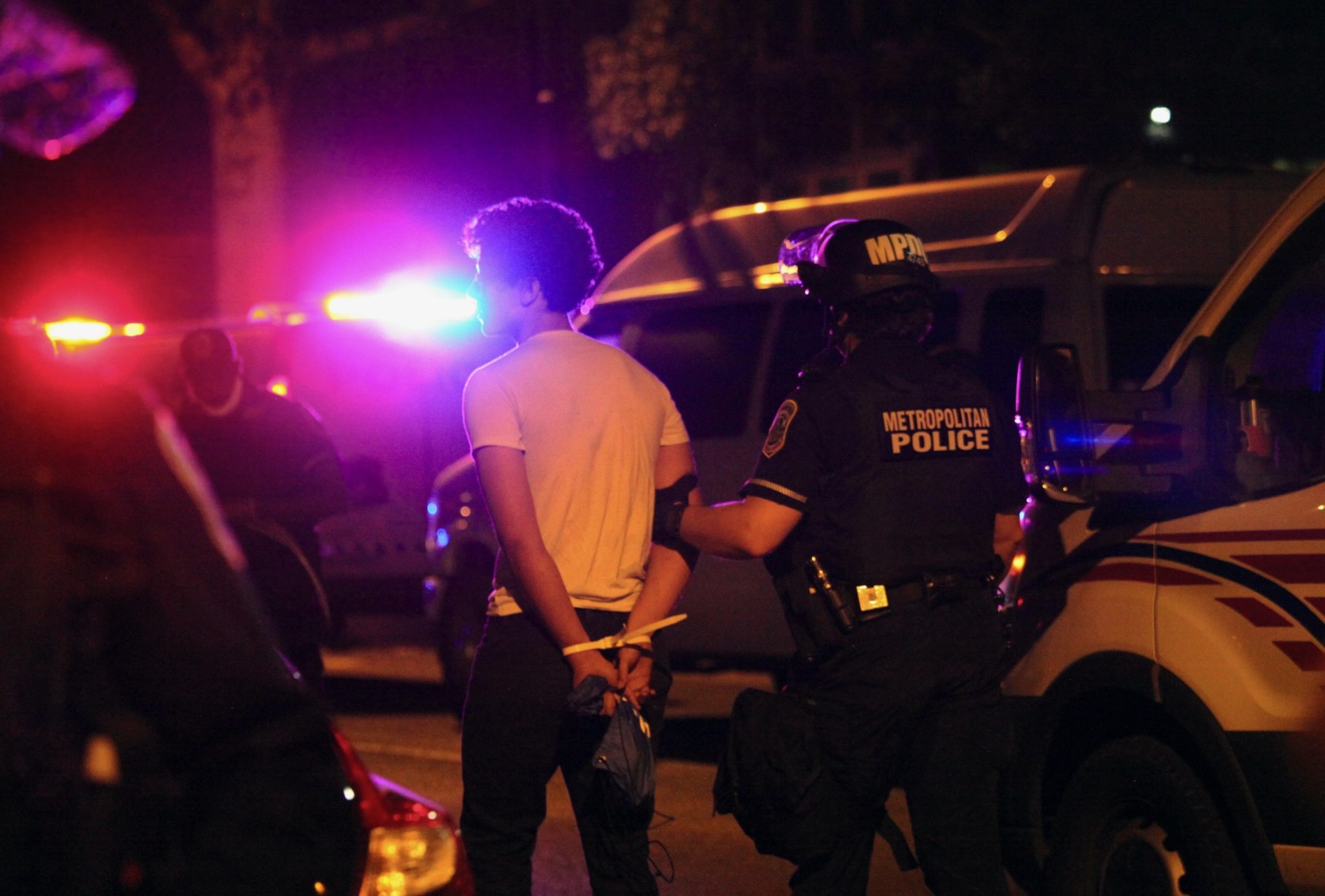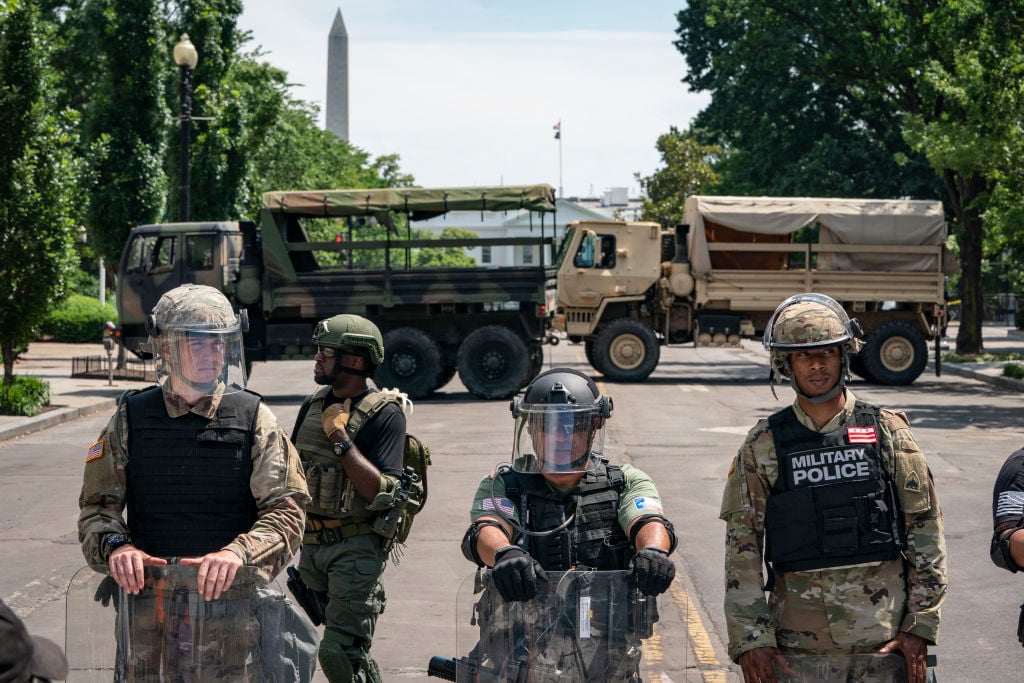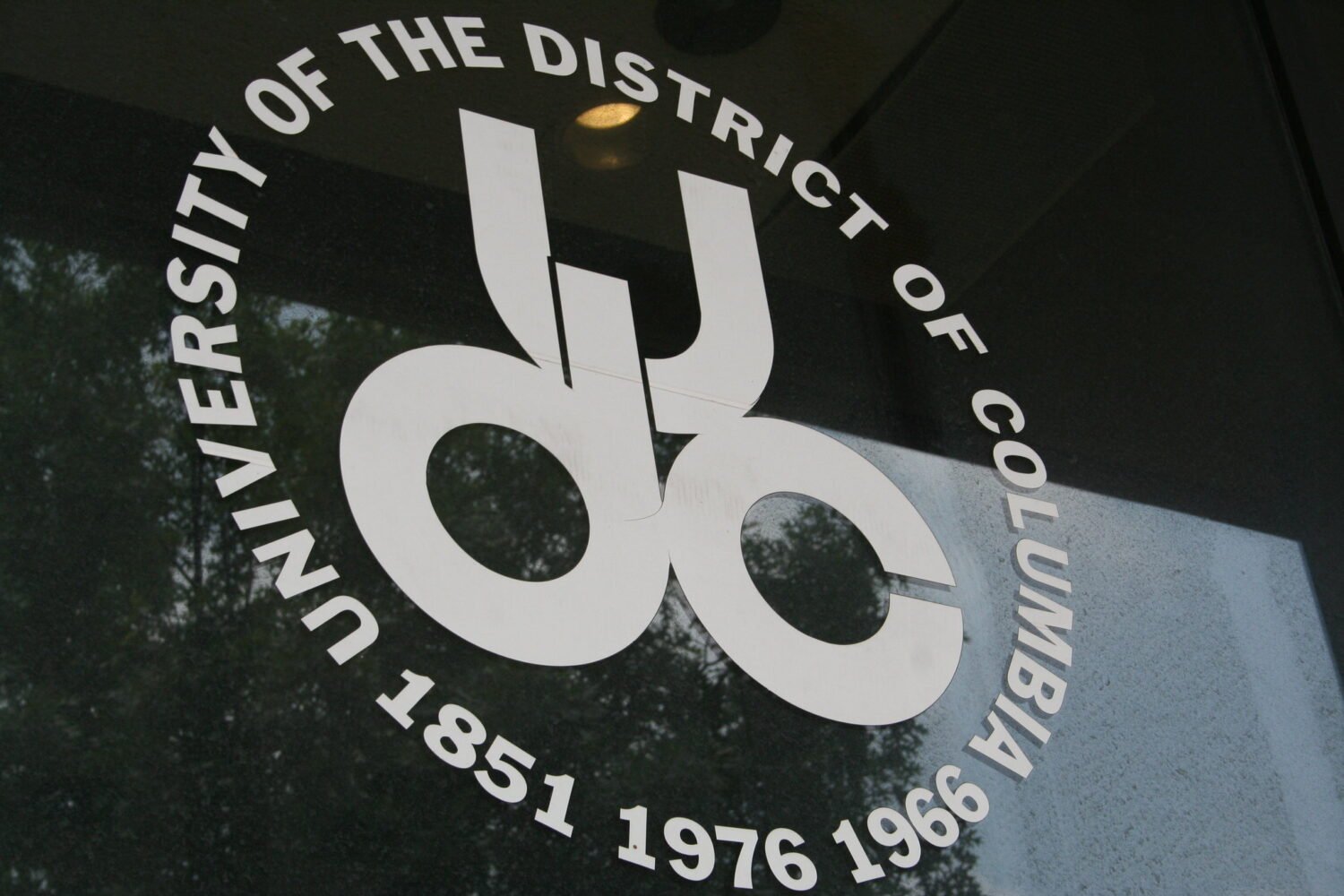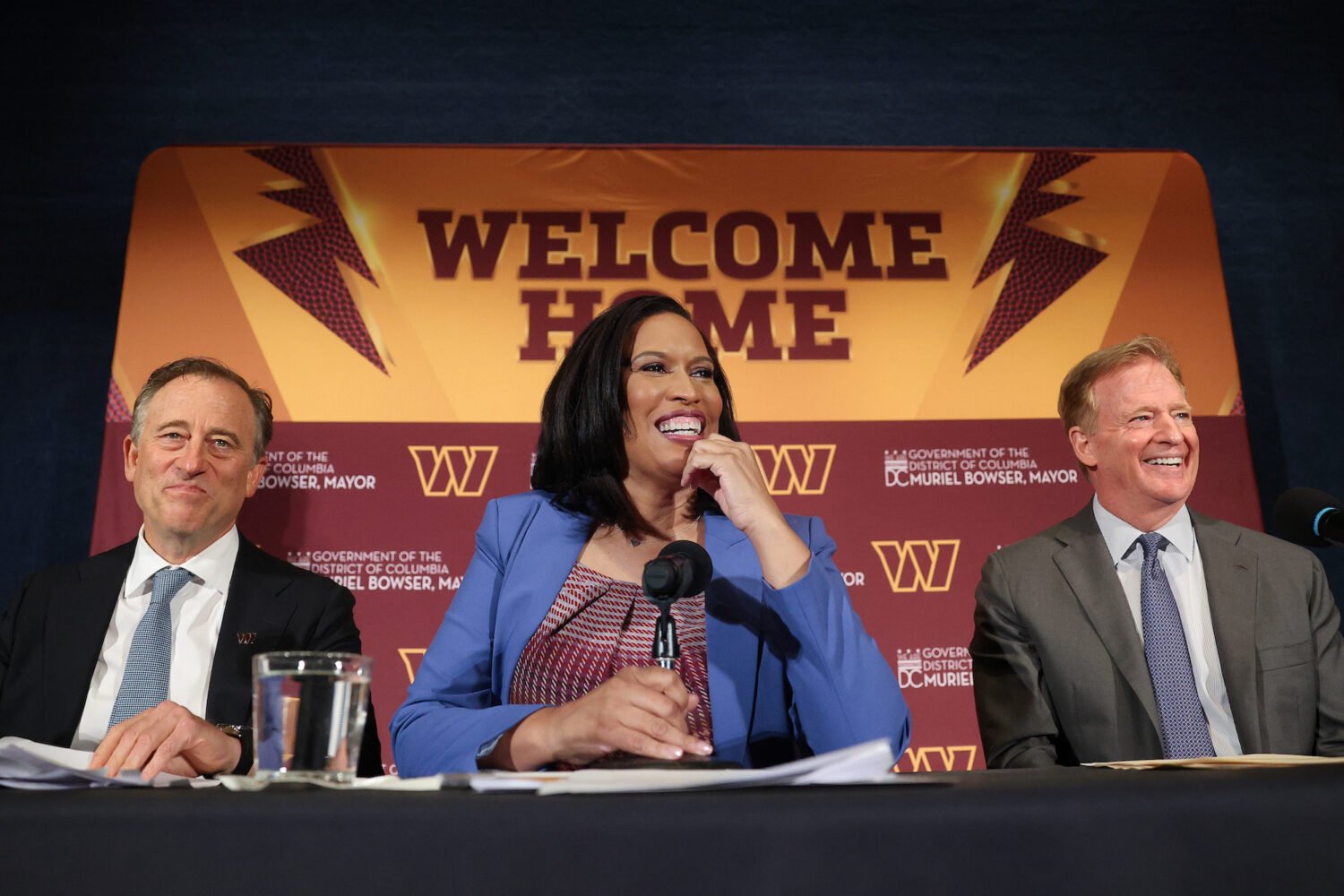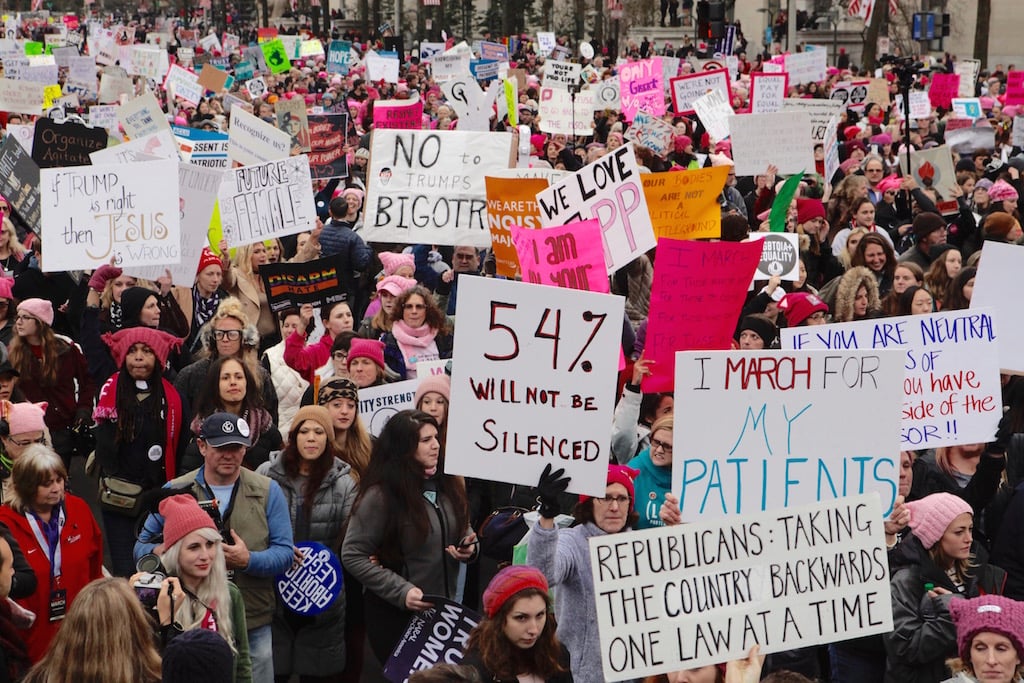About Coronavirus 2020
Washingtonian is keeping you up to date on the coronavirus around DC.
On Wednesday, June 3, DC Police Chief Peter Newsham addressed tactics his force used two evenings earlier when arresting a group of protesters on the 1400 block of Swann Street, Northwest. “It was a mass arrest,” he said. “[It’s] something we don’t like to do, but we feel like we have to do it in the instance that we believe we have a threat to public safety.”
Newsham said prior to the arrest, police were monitoring a group exhibiting similar behaviors to the individuals who had engaged in looting and rioting on Saturday and Sunday nights. “Some of that behavior was the throwing of different projectiles, and also the burning of a Metropolitan Police Department police vehicle,” Newsham said.
Police continued to monitor that group, and eventually “stopped” them on Swann Street around 9 PM, Newsham said. He said protesters had been given multiple warnings that a 7 PM curfew was in effect for that evening, and that anyone who did not abide by it would be subject to arrest. One of those warnings came from officers over their public address systems, he said.
When police began conducting arrests on Swann Street, Newsham said multiple officers patched radio transmissions saying the protesters were “kicking in doors,” and that police had reason to believe residences were being entered and burglaries were occurring. Given the situation, police deployed pepper spray.
Newsham questioned some of the accounts Rahul Dubey—a resident of Swann Street who sheltered a number of the protesters—had provided to journalists. Newsham said he had no evidence of police “beating on people, putting their faces into cement,” or that protesters were “decimated” by the officers on the scene.
Police reported all the arrests on the scene were met “without resistance,” Newsham said, and that “there were no visible injuries to any of the persons that were arrested.”
Newsham praised his department for showing “judgment and restraint” throughout the situation. “When you had people running into a home [and] some belief it could have been a very serious felony of breaking into someone’s home…for the police not to enter that home and exacerbate that situation, I think it’s something at the end of the day we’ll look back on and be proud of our agency for doing.”
Newsham’s account of what happened at Swann Street sharply deviates from what my colleagues had previously reported and from what I saw on social media from individuals on the scene. This account is based on interviews with 15 people who were part of the action on Monday night. Their accounts were largely identical. Here’s what they say happened on Swann Street.
A number of the Swann Street protestors had been part of the group teargassed and forcibly removed from Lafayette Square under the orders of Attorney General Bill Barr. Others had taken part in a demonstration around Dupont Circle. The core of the group had been peacefully making its way up 14th Street from downtown, slowly adding numbers as it continued to march into Columbia Heights. Suddenly, at 8:40 PM at 14th and Belmont streets, five police cars came tearing uptown with their lights flashing and sirens wailing.
When the cars reached the rear of the group, the protesters formed a line out of concern that the police might ram into the crowd. As reinforcements arrived and police began to block off the street, protesters raised their hands in the air and started yelling, “Don’t shoot! Black Lives Matter! We’re peaceful!” a protester we agreed to call Warren says.
A few plastic water bottles were thrown from the crowd at the police cars; none were thrown directly at officers. A number of individuals told me the group immediately started yelling at the bottle-throwers, and one protester we agreed to call Andre says the group “told [them] to leave, because we wanted to be peaceful.” It seems the police interpreted the bottles as a sign of aggression, because they deployed a flashbang grenade. The crowd peacefully held the line, and at 8:44 PM, the police retreated downtown on 14th Street.
Those I talked to say the movement felt disoriented after the action. A number of individuals continued to move uptown, but momentum from the police interaction sent a large chunk of the protesters back downtown on 14th Street. When they reached Florida Avenue, they were met by a large group of officers on bikes, who seemed to direct the crowd through residential roadways onto 15th Street, where they continued to march downtown. A number of those I spoke to said it was around this point they began to feel like the police were herding them.
Around 9 PM, the group attempted to get back to 14th Street, a wider roadway more conducive to marching. The few hundred remaining protesters made their way east on Swann Street, only to encounter a police line blocking off access to 14th Street. When the group attempted to turn back to 15th Street, they found a police line there as well. Every alleyway on the block was choked by police. Almost immediately, it became apparent the group was trapped.
Individuals described rising tensions at this point. The group was overwhelmingly young—mostly college kids—and there were a number of minors present. Protesters recount kids in their mid-teens futilely asking police to be released, saying their moms had told them to come home. Ryan O’Leary says a 12-year-old African American boy was being comforted by an older African American protester who was explaining what was going to happen and was telling him what he needed to do to stay safe.
Despite mounting fear, every individual I spoke with says the protesters remained totally peaceful, with not so much as one flying water bottle. When one protester attempted to climb on top of a car to get a better view of what was happening, the crowd immediately yelled at him to get down to avoid escalating the situation, O’Leary says.
Then, around 9:30, police began to move in with zero warning. I spoke with individuals who were directly in front of police lines on both the 14th and 15th Street sides. None of them heard a verbal warning about an order to disperse or curfew violation at any time, nor did the two Mother Jones journalists I spoke with who were standing just outside police lines.
“There was no moment where the police said, ‘This is your final warning, go home or we’re going to arrest you,'” Sebi Medina-Tayac says. “There was no point where they got on the loudspeaker and said, “Anyone who is a child or minor, please come forward, we’re going to release you to your parents.” They never got on the loudspeaker and said, “You are in violation of a curfew.”
As the police began to push forward and pack the crowd together, individuals described a “fight or flight” response taking place. Those who attempted to peacefully hold the line with their hands raised above their heads were pushed back with riot shields. “[These were] big, weighted shields,” says Allison Lane. “[And] it was not like pushing your buddy on the playground. It was like, “I’m trying to knock down a wall.”
“I saw them push a young woman to the ground,” says Gregory Altman. “I saw another individual get pinned up against a bicycle and a car who didn’t have anywhere to go.” Medina-Tayac says he saw an officer punch a woman in the face.
Altman tried to help people up from the ground and make sense of the situation. “I confronted an officer that was pushing protesters back and was like, “Why are you doing this?” I probably threw in some curse words, but I didn’t act out. I didn’t touch anyone, I didn’t throw anything, I just got too close to them. And I was pepper sprayed right in the face from one foot away. Then they started spraying everyone.”
Seeing the chaos and reacting to the effects of chemical agents, protesters attempted to seek shelter in the surrounding residences. Those I spoke to said many Swann Street residents had been watching the situation from their windows, their fists raised in solidarity. When they saw the police deploy pepper spray, a number of them threw open their doors to shelter protesters.
Everyone I spoke to agreed: until the police started moving in, nobody had been trying to obtain access to nearby residences. A protester we agreed to refer to as Eric Y says there were a couple residents who had their doors open and were clearly ushering protesters inside. Warren says she spoke to a few homeowners the next morning who said, “I’m so glad we could help you guys, I’m so glad we could get you off the street.”
The vast majority of the protesters who were seeking shelter went towards open doors; once those residences were full a few demonstrators knocked on closed doors. Everyone I spoke to said any requests for entry were respectful, and that nobody was trying to “kick in” doors or forcefully gain entry.
Warren had been ushered into a basement apartment, and could hear what was going on at the unit above her. “We heard people run up the steps to the front door of the apartment above us,” she says. “And they knocked. Even though the police were already closing in, these people knocked and begged to be let in; they did not even begin to try to knock down that door. And these are desperate people.”
About 70 protesters gained sanctuary in the residence of Rahul Dubey, who was clearly ushering protesters into his home. The individuals I spoke to who took shelter there said police continued to pepper spray protesters as they ran into the house, and a number of protesters saw police spraying mace directly into the windows.
“The burning I felt [from the pepper spray] significantly increased when I went inside the home,” Eric Y. says. “I remember going upstairs and seeing people by the windows reacting to the pepper spray.” Andre had a similar experience. “We were inside, and people were coughing their lungs out,” he said. “People were running everywhere and they had mace in their eyes…When we first got in, we went to the third floor; we couldn’t breathe. We went to the basement and it was chaos.”
Several of the individuals I spoke with say they witnessed racial profiling during the scuffle. Warren says she saw police reach past white people to shove or pepper spray black individuals, and Lane concurs that the majority of the individuals being shoved to the ground were people of color.
Though the initial escalation was intense, it was brief: maybe 10 or 15 minutes in all. O’Leary was one of the roughly 200 individuals who was unable to escape or seek shelter. He says the remaining group had been confined into a space of roughly 75 square feet.
Around 9:45 p.m., police began to haphazardly grab protesters close to them and take them behind police lines to be arrested. The individuals I spoke with say there was no warning the police were beginning arrests at this point, so the crowd was confused and scared, and wasn’t sure what was happening to fellow protesters. Both a protester we agreed to refer to as Devon and Medina-Tayac said police were only grabbing men, and seemed to be targeting men of color. When the group realized what was happening, O’Leary says white female protesters formed a line in front of the police, with everyone else standing ten feet behind them.
Once that line was formed, the situation seemed to slightly de-escalate, and police asked volunteers to willingly come forward to be arrested. Police would ask for a specific number of men at one time, then a specific number of women. If too few individuals willingly came forward for arrest in any group, police would start cherry-picking protesters again. Devon was one of the last individuals to be arrested; she says she was taken into police custody around 1:30 AM.
Meanwhile, the protesters who had taken shelter in Swann Street homes began to realize police were waiting to arrest them outside. Trapped, Andre watched as police began slowly arresting his fellow protesters. “At one point, I was looking out the window and I saw some officers talking about something and chuckling and laughing,” he says. “I don’t know what they were laughing about, but I thought it was a little insensitive. We’re in here, scared for our lives, and you’re laughing. I understand that getting arrested is not the end of the world…but as a black man it’s hard.”
Individuals who sheltered in Dubey’s home say police remained outside the house well after arrests concluded. Throughout the course of the night, officers tried to bar food deliveries to the house, and attempted to coerce protesters to come outside. Eventually, around 4:30 AM, some neighbors came outside and finally convinced the police to leave the street. To ensure their safety, all of the protesters remained in the homes until 6 AM Tuesday when curfew lifted.
All told, 194 individuals were arrested on Swann Street. Four of the 190 were minors.
When asked for comment, the DC Police Department provided this response: “All MPD police officers are equipped with body worn cameras (BWC) so that we have a full account of any interactions they have with the public. The benefit of a BWC program is that all videos can be reviewed in order to see if officers involved followed appropriate police procedures. If anyone has concerns regarding the way they were treated by an MPD Officer, we ask that they file a complaint with MPD or the independent Office of Police Complaints.”
Because of allegations of excessive force, MPD’s internal affairs bureau will be conducting an investigation of what happened on Swann Street. The press and public will likely not have access to any of the BWC footage until that investigation concludes, which could take weeks.
The American Civil Liberties Union is currently investigating Monday night’s incident on Swann Street. Monica Hopkins, executive director of ACLU DC, says the organization feels DC Mayor Muriel Bowser’s 7 PM curfew was “heavy handed,” and was “troubled” by accounts of police kettling – the technical term for police entrapping protesters in a confined space. Kettling is all but illegal in the District, and Hopkins says it was disturbing to see the tactic used in the midst of a pandemic, as it gave protesters no opportunity to safely social distance.
Hopkins also notes, “This is a police force that does not have a very good history with protests and kettling people in this way.” Newsham ordered an infamous kettling in Pershing Park in 2002, where many protesters were hogtied, held for hours, and some were falsely told they could only leave if they paid a fine. DC police implemented the tactic again during the 2017 inauguration protests when Newsham was acting police chief.
“Ultimately, it’s a leader’s role to set the tone for your entire team,” Hopkins says. “This is a police chief who has a history of using these practices and tactics to quell free speech.”
Note: Given the sensitive nature of this situation and reported increased government surveillance of protesters, some names have been omitted or changed.

